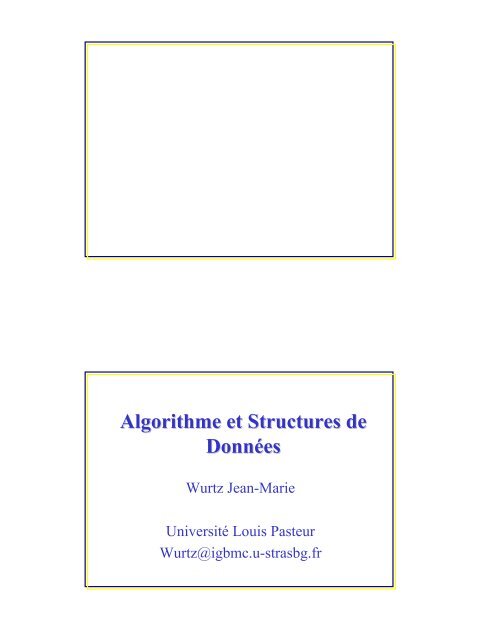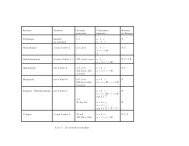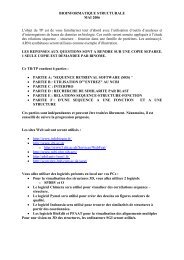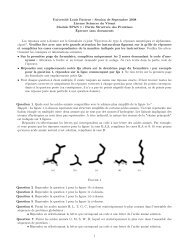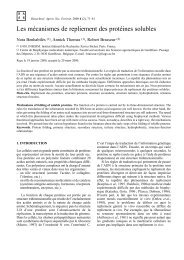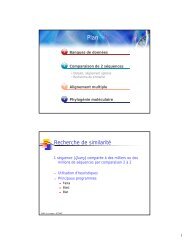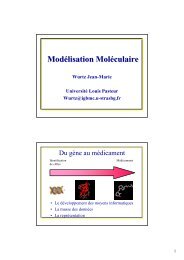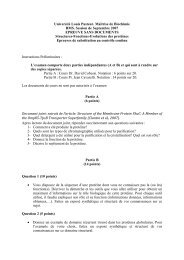Algorithme et Structures de Données
Algorithme et Structures de Données
Algorithme et Structures de Données
Create successful ePaper yourself
Turn your PDF publications into a flip-book with our unique Google optimized e-Paper software.
<strong>Algorithme</strong> <strong>et</strong> <strong>Structures</strong> <strong>de</strong><br />
<strong>Données</strong><br />
Wurtz Jean-Marie<br />
Université Louis Pasteur<br />
Wurtz@igbmc.u-strasbg.fr
Plan du cours<br />
• Analyse d'algorithmes<br />
• Complexité/Formalisme<br />
• Récursivité<br />
• Tri<br />
• Arbre<br />
• alignement optimal<br />
• Triangle <strong>de</strong> Delaunay<br />
• graphe<br />
Java<br />
Analyse d'un algorithme<br />
• But :<br />
– estimer son temps d'exécution<br />
– comparer 2 algorithmes<br />
• Le temps d'exécution peut dépendre :<br />
– <strong>de</strong> l'ordinateur<br />
– <strong>de</strong> la nature <strong>de</strong>s instructions<br />
– du compilateur<br />
– du programmeur<br />
– du système d'exploitation<br />
– <strong>de</strong>s données à traiter<br />
– <strong>de</strong> la complexité
Références bibliographiques<br />
• "Algorithms in Java"; Robert Sedgewick & Michael<br />
Shildlowsky; Third edition, Parts 1-4 : Fundamentals, data<br />
structures, sorting & searching; Addison-Wesley.<br />
• "Algorithms in Java"; Third edition, Part 5 : Graph<br />
algorithm; Robert Sedgewick & Michael Shildlowsky;<br />
Addison-Wesley.<br />
• "Data Structure and Algorithm"; Alfred V. Aho, John E.<br />
Hopcroft, Jeffrey D. Ullman; Addison-Wesley.<br />
• "Algorithmique du texte"; Maxime Crochemore,<br />
Christophe Hancart, Thierry Lecroq; Vuibert.<br />
Implémentation d'un algorithme<br />
• Ecriture en Java : mais peut-être implémenté dans<br />
n'importe quel autre langage<br />
• Un algorithme fait parti d'un gros programme<br />
– utilisation <strong>de</strong> structure <strong>de</strong> données abstraites<br />
– peuvent être substituées<br />
• Dès le début : connaître les performances d'un<br />
algorithme<br />
• Tout le système en dépend (recherche, tri, …)
Implémentation d'un algorithme (2)<br />
• 2 cas typiques qui nécessitent <strong>de</strong>s algorithmes<br />
efficaces :<br />
– taille du problème énorme<br />
– co<strong>de</strong> exécuter un grand nombre <strong>de</strong> fois<br />
• Recherche d'algorithme plus efficace <strong>et</strong> si possible<br />
simple<br />
Analyse empirique d'un algorithme ?<br />
Analyse mathématique d'un algorithme ?<br />
Analyse empirique<br />
• Soit 2 algorithmes réalisant la même tâche<br />
– compare temps d'exécution sur <strong>de</strong>s entrées typiques<br />
– 3 s ou 30 s d'attente pour l'utilisateur feront une gran<strong>de</strong><br />
différence<br />
– perm<strong>et</strong> aussi <strong>de</strong> vali<strong>de</strong>r une analyse mathématique<br />
• Si le temps d'exécution <strong>de</strong>vient trop long, l'analyse<br />
mathématique s'impose<br />
– attente pouvant être <strong>de</strong> l'ordre <strong>de</strong> l'heure ou du jour
Temps d'exécution<br />
int i, j, k, count=0;<br />
for (i=0; i < N; i++)<br />
for (j=0; j < N; j++)<br />
for (k=0; k < N; k++)<br />
count++;<br />
10 -6 s pour une instruction<br />
Temps pour N= 10, 100, 1000, 100000 ou 1 million<br />
10-3s 1s 1000s 1 an 10 siècles<br />
Analyse empirique (3)<br />
• Nécessite l'implémentation d'une première version<br />
d'un algorithme !!!<br />
• Nature <strong>de</strong>s données à tester<br />
– données typiques<br />
– données aléatoires<br />
– données extrêmes<br />
• Attention à la comparaison<br />
– soin accordé à l'implémentation<br />
– différences entre ordinateurs, compilateurs, systèmes<br />
d'exploitation, ….
Choix d'un algorithme<br />
• Si plusieurs algorithmes sont disponibles ?<br />
• Choix :<br />
– du plus facile à comprendre, à co<strong>de</strong>r <strong>et</strong> à<br />
<strong>de</strong>bugger<br />
– du plus rapi<strong>de</strong> <strong>et</strong> utilisant efficacement les<br />
ressources<br />
Choix <strong>de</strong> l'algorithme (2)<br />
• <strong>Algorithme</strong> rapi<strong>de</strong> souvent plus compliqué qu'un<br />
algorithme "brute force"<br />
– problèmes <strong>de</strong> gran<strong>de</strong> taille -> algorithme rapi<strong>de</strong><br />
• Rien ne sert <strong>de</strong> multiplié par 10 la performance <strong>de</strong><br />
l'algorithme si celui-ci<br />
– ne prend que quelques millisecon<strong>de</strong>s<br />
– <strong>et</strong> est très peu utilisé<br />
• Le temps <strong>de</strong> développement peut-être prohibitif<br />
• un programme non écrit ne peut-être testé!
Outil mathématique<br />
• Mesure générale <strong>de</strong>s performances d'un<br />
algorithme<br />
• Comparer 2 algorithmes pour la même<br />
tâche<br />
• Prédire la performance dans un nouvel<br />
environnement<br />
Analyse mathématique<br />
• L'analyse mathématique d'un algorithme peut-être<br />
complexe<br />
• Une spécialité en informatique<br />
• Paramètres hors <strong>de</strong> portée du programmeur Java :<br />
– temps d'exécution d'une instruction (MV/compilateur)<br />
– ressources partagées<br />
– dépendance <strong>de</strong>s données en entrée<br />
– certains algorithmes sont tout simplement complexes <strong>et</strong><br />
il n'y a pas <strong>de</strong> résultat mathématique pour les décrire
Analyse mathématique (2)<br />
• Néanmoins il est possible <strong>de</strong> prédire<br />
– la performance d'un algorithme<br />
– si un algorithme est meilleur qu'un<br />
autre<br />
• Premières étapes:<br />
– i<strong>de</strong>ntifier les opérations abstraites <strong>de</strong> l'algorithmes<br />
– exemple <strong>de</strong> la triple boucle, le nombre d'exécutions <strong>de</strong><br />
l'instruction : count++<br />
– sans tenir compte du temps en millisecon<strong>de</strong><br />
– c<strong>et</strong>te séparation perm<strong>et</strong> <strong>de</strong> comparer <strong>de</strong>s algorithmes<br />
Temps d'exécution<br />
int i, j, k, count=0;<br />
for (i=0; i < N; i++)<br />
for (j=0; j < N; j++)<br />
for (k=0; k < N; k++)<br />
count++;<br />
10 -6 s pour une instruction<br />
Le nombre d'instructions<br />
peut varier<br />
Temps pour N= 10, 100, 1000, 100000 ou 1 million<br />
10-3s 1s 1000s 1 an 10 siècles
Les entrés testées par l'algorithme<br />
• Plusieurs cas sont envisagés:<br />
– le cas moyen : fiction mathématique<br />
– le pire <strong>de</strong>s cas : construction qui se produit que<br />
rarement<br />
– donnent néanmoins <strong>de</strong>s informations clés<br />
• Exemple :<br />
– recherche séquentiel d'un nombre dans un tableau<br />
static int search(int a[], int v, int l, int r) {<br />
int i;<br />
for (i = l; i
Type <strong>de</strong> fonctions<br />
• 1 instructions exécutées un nombre limité <strong>de</strong> fois;<br />
exécution constante<br />
• log N division du problème pour le résoudre; exécution<br />
logarithmique<br />
• N exécution linéaire<br />
• N*log Nrésolution <strong>de</strong> pbs plus p<strong>et</strong>its, puis recombinaison <strong>de</strong>s<br />
solutions<br />
•N 2 utilisable sur <strong>de</strong> p<strong>et</strong>its pbs; exécution quadratique<br />
•N 3 triple boucle sur les données<br />
•2 N exécution exponentielle; N=20 alors 2 N =1 million<br />
Fonctions<br />
rencontrées<br />
Copyright " 'Algorithms in Java'; Robert Sedgewick & Michael Shildlowsky; Third edition, Parts 1-4; Addison-Wesley "<br />
Reproduction ULP Strasbourg. Autorisation CFC - Paris
Temps requis pour résoudre <strong>de</strong> gros<br />
problèmes<br />
Copyright " 'Algorithms in Java'; Robert Sedgewick & Michael Shildlowsky; Third edition, Parts 1-4; Addison-Wesley "<br />
Reproduction ULP Strasbourg. Autorisation CFC - Paris<br />
Fonctions spéciales<br />
fonctions noms valeurs types approximation<br />
1 1 1<br />
H N = 1+<br />
+ + ... +<br />
2 3 N<br />
1<br />
≈ ln N + γ +<br />
12N<br />
γ=0,57721, constante d'Euler<br />
Copyright " 'Algorithms in Java'; Robert Sedgewick & Michael Shildlowsky; Third edition, Parts 1-4; Addison-Wesley "<br />
Reproduction ULP Strasbourg. Autorisation CFC - Paris
Une mesure générale <strong>de</strong>s<br />
performances d'un algorithme<br />
La notation O :<br />
Soit <strong>de</strong>ux fonctions f(x) <strong>et</strong> g(x) avec x ≥ 0<br />
On dit que f(x)=O( g(x) ) si<br />
∃ N 0 ≥ 0, ∃ c 〉 0, ∀ N ≥ N 0 f (N) ≤ c . g (N)<br />
A partir d'un certain rang, la fonction « g » majore la fonction<br />
« f » à un coefficient multiplicatif près.<br />
On peut encore écrire :<br />
g est une borne supérieure <strong>de</strong> f<br />
lim<br />
n→<br />
∞<br />
La notation grand-O grand<br />
f ( n)<br />
= c<br />
g(<br />
n)<br />
• ∃ N 0 ≥ 0, ∃ c 〉 0, ∀ N ≥ N 0 f (N) ≤ c . g (N)<br />
• C<strong>et</strong>te notation perm<strong>et</strong> <strong>de</strong> :<br />
– limiter l'erreur quand on ignore les termes plus p<strong>et</strong>its dans une<br />
formule mathématique<br />
– limiter l'erreur quand on ignore certaines parties du programme qui<br />
prennent peut <strong>de</strong> temps<br />
– classer les algorithmes en fonction <strong>de</strong> leur comportement<br />
asymptotique (avec N grand)<br />
• Les constantes N 0 <strong>et</strong> c 0 cachent <strong>de</strong>s détails<br />
d'implémentation<br />
• si N < N 0 on ne connaît pas le comportement <strong>de</strong><br />
l'algorithme<br />
• On ne s’intéresse qu'aux termes les plus grands : comparer<br />
N 2 nanosecon<strong>de</strong>s <strong>et</strong> logN siècles
Temps d'exécution <strong>de</strong> 4 programmes<br />
Copyright " 'Data Structure and Algorithm'; Alfred V. Aho, John E. Hopcroft, Jeffrey D. Ullman; Addison-Wesley "<br />
Reproduction ULP Strasbourg. Autorisation CFC - Paris<br />
Approximation <strong>de</strong> « grand-O grand » :<br />
g(N) = O(f(N))<br />
f est proportionnelle à g<br />
g(N)<br />
notre fonction<br />
f(N)<br />
approximation<br />
N > N o<br />
c*f(N)<br />
Copyright " 'Algorithms in Java'; Robert Sedgewick & Michael Shildlowsky; Third edition, Parts 1-4; Addison-Wesley "<br />
Reproduction ULP Strasbourg. Autorisation CFC - Paris
Approximation<br />
<strong>de</strong> la fonction<br />
• g(N) proportionnelle à f(N)<br />
• g(N) croit comme f(N) à<br />
une constante "c" près<br />
• Estimation pour N grand<br />
g(N)<br />
g(N) ≤ c * f(N) pour N > N o<br />
N o<br />
f(N)<br />
c*f(N)<br />
Copyright " 'Algorithms in Java'; Robert Sedgewick & Michael Shildlowsky; Third edition, Parts 1-4; Addison-Wesley "<br />
Reproduction ULP Strasbourg. Autorisation CFC - Paris<br />
Autres notation<br />
Ω( g ) : l'ensemble <strong>de</strong>s fonctions dont la croissance est<br />
similaire à g<br />
g est une borne inférieure<br />
∃ N 0 ≥ 0, ∃ c 〉 0, ∀ N ≥ N 0 f(N) ≥ c*g(N)<br />
g(N)
Approximation<br />
<strong>de</strong> la fonction<br />
• g(N) proportionnelle à f(N)<br />
• g(N) croit comme f(N) à<br />
une constante "c" près<br />
• Estimation pour N grand<br />
g(N)<br />
g(N) ≤ c * f(N) pour N > N o<br />
N o<br />
f(N)<br />
c*f(N)<br />
Copyright " 'Algorithms in Java'; Robert Sedgewick & Michael Shildlowsky; Third edition, Parts 1-4; Addison-Wesley "<br />
Reproduction ULP Strasbourg. Autorisation CFC - Paris<br />
Propriétés <strong>de</strong> la notation O (1)<br />
• Les constantes peuvent être ignorées :<br />
∀ k > 0, k*f est O( f)<br />
• Les puissances supérieures croissent plus rapi<strong>de</strong>ment :<br />
si f est un polynôme <strong>de</strong> <strong>de</strong>gré d alors f est O(n d )<br />
• Les termes croissants rapi<strong>de</strong>ment dominent la somme<br />
si f est O(g), alors f + g est O(g)<br />
ex: an 4 + bn 3 est O(n 4 )<br />
• Une croissance polynomiale est dictée par la puissance la<br />
plus élevée<br />
n r est O( n s ) si 0 ≤ r ≤ s<br />
g(N)
Propriétés <strong>de</strong> la notation O (2)<br />
• f est O(g) est transitif :<br />
si f est O(g) <strong>et</strong> g est O(h) alors f est O(h)<br />
• Le produit <strong>de</strong>s bornes supérieurs est la borne supérieur du<br />
produit :<br />
si f est O(g) <strong>et</strong> h est O(r) alors f*h est O(g*r)<br />
• Les fonctions exponentielles croissent plus vite que les<br />
puissances :<br />
nk est O( bn ) ∀ b > 1 <strong>et</strong> k ≥ 0<br />
ex : n20 est O( 1.05n )<br />
• Les logarithmes croissent plus lentement que les<br />
puissances :<br />
logbn est O( nk ) ∀ b > 1 <strong>et</strong> k > 0<br />
ex: log2n est O( n0.5 )<br />
Propriétés <strong>de</strong> la notation O (3)<br />
• Tous les logarithmes croissent <strong>de</strong> manière similaire<br />
log b n is O(log d n) ∀ b, d > 1<br />
• La somme <strong>de</strong>s n premières puissances <strong>de</strong> r croit comme la<br />
puissance <strong>de</strong> (r+1)<br />
n<br />
r<br />
∑ k<br />
k = 1<br />
r<br />
∑ k =<br />
k<br />
= 1<br />
n(<br />
n + 1)<br />
2<br />
est O( n r+1 )<br />
ex : is Ο( n 2 )
<strong>Algorithme</strong>s polynomiaux <strong>et</strong><br />
difficiles<br />
• <strong>Algorithme</strong> polynomiale<br />
– s'il est O(n d ) pour un entier "d" donnée<br />
– les algorithmes polynomiaux sont dits efficaces<br />
• Ils peuvent être résolus en un temps raisonnable<br />
• <strong>Algorithme</strong>s difficiles<br />
– algorithmes pour lesquels il n'y a pas d'algorithme avec<br />
un temps polynomiale<br />
Coût <strong>de</strong>s instructions<br />
• Instructions simples : a=b; a+=b; … O(1)<br />
s 1 ; s 2 ; …. ; s k O(1) si k est une constante<br />
• boucle simple : O(N)<br />
for(i=1; i
Exemple avec O(N)<br />
• T(0)=1<br />
• T(1)=4<br />
• T(N)=(N+1) 2<br />
• T(N) est O(N2 ) avec N0 =1 <strong>et</strong> c=4<br />
• T(N) ≤ 4*N2 pour N ≥ N0 =1<br />
•N0 =0 n'est pas possible car T(0)=1 or<br />
c*02 =0 pour toutes constantes c<br />
Exercice avec O(N) (1)<br />
• montrer que O(1) est la même chose que O(2) ?<br />
∃ N0 ≥ 0, ∃ c 〉 0, ∀ N ≥ N0 f (N) ≤ c . g (N)<br />
• Cela revient à trouver 2 entiers N0 <strong>et</strong> c<br />
avec : g(N)=1 <strong>et</strong> la fonction f(N)=2<br />
• N0 = 0 <strong>et</strong> c = 2 on a bien 2 ≤ c*1=2<br />
pour tout Ν ≥ N0 = 0
Exercice avec O(N) (2)<br />
• Montrer que la fonction T(n) = 3n 3 + 2n 2 est O(n 3 )<br />
• Trouver N 0 <strong>et</strong> c tel que :<br />
∃ N 0 ≥ 0, ∃ c 〉 0, ∀ n ≥ N 0 f (n) ≤ c . g (n)<br />
• avec N 0 = 0 <strong>et</strong> c = 5<br />
• 3n 3 + 2n 2 ≤ 5n 3<br />
Exercice avec O(N) (3)<br />
• montrer que 3 N n'est pas O(2 N )<br />
• Supposons qu'il existe 2 constantes c <strong>et</strong> N 0 tel que<br />
N ≥ N 0 pour lesquelles l'inégalité suivante est<br />
vérifiée : 3 N ≤ c*2 N<br />
• alors c ≥ (3/2) N , c peut <strong>de</strong>venir arbitrairement<br />
grand pour N grand, donc il n'existe pas <strong>de</strong><br />
constante supérieure (3/2) N quelque soit N
Exercice avec O(N) (4.1)<br />
• <strong>Algorithme</strong> :<br />
– Initialisation exécutée 1 fois (temps : a1 ns)<br />
– une boucle interne parcourue 2N*HN (temps : a2 ns; avec HN le nombre harmonique)<br />
– une section supplémentaire exécutée N fois<br />
(temps : a3 ns)<br />
• Temps moyen d'exécution <strong>de</strong> l'algorithme?<br />
• a1 + 2a2N*HN + a3*N ns<br />
Exercice avec<br />
O(N) (4.2)<br />
1 1 1<br />
H N = 1+<br />
+ + ... +<br />
2 3 N<br />
1<br />
≈ ln N + γ<br />
+<br />
12N<br />
• Avec la notation O(N) que <strong>de</strong>vient c<strong>et</strong>te estimation ?<br />
a1 + 2a2N*HN + a3 *N ns<br />
• 2a2N*HN + O(N)<br />
• Une forme plus simple qui indique que ce n'est pas la peine<br />
<strong>de</strong> chercher a1 <strong>et</strong> a3 • Temps d'exécution exprimer en notation « grand-O » ?<br />
• HN =ln(N) + O(1) on obtient ainsi 2a2N*Ln(N)+ O(N)<br />
• l'expression asymptotique du temps total d'exécution :<br />
temps proche <strong>de</strong> 2a2N*Ln(N) pour <strong>de</strong>s N grands
Exercice avec O(N) (4.3)<br />
• l'expression asymptotique du temps total d'exécution :<br />
temps proche <strong>de</strong> 2a 2 N*Ln(N) pour <strong>de</strong>s N grands<br />
• que se passe-t-il si N double : taille 2N?<br />
2a2(<br />
2N<br />
) ln( 2N<br />
) + O(<br />
2N<br />
) 2ln(<br />
2N<br />
) + O(<br />
1)<br />
=<br />
2a<br />
N ln N + O(<br />
N)<br />
ln N + O(<br />
1)<br />
2a 2N en facteur<br />
2<br />
1<br />
= 2 + O(<br />
)<br />
ln N<br />
• sans connaître a 2 on peut prédire que le temps doublera<br />
pour le traitement <strong>de</strong>s données <strong>de</strong> taille 2N<br />
Application : Recherche du<br />
maximum<br />
• Recherche séquentielle :<br />
•<br />
l r<br />
static int search(int a[], int v, int l, int r)<br />
{<br />
int i;<br />
Analyse <strong>de</strong> l'algorithme?<br />
for (i = 1; i
Recherche séquentielle : coût?<br />
• static int search(int a[], int v, int l, int r)<br />
{<br />
int i;<br />
for (i = 1; i >N)<br />
• La recherche séquentielle : M*N<br />
• La recherche binaire : NLogN + M*?
Recherche binaire<br />
static int search(int a[], int v, int l, int r)<br />
{<br />
while(r>=l) {<br />
int m = (l+r)/2;<br />
if (v == a[m]) r<strong>et</strong>urn m;<br />
if (v < a[m]) r = m-1; else l = m+1;<br />
}<br />
r<strong>et</strong>urn -1;<br />
}<br />
Propriété : la recherche binaire examine au plus ⎣lgN⎦ + 1<br />
11 nombres<br />
23 nombres<br />
Recherche binaire<br />
1. Recherche <strong>de</strong> 5025<br />
2. Comparaison à 6504; 1 ère<br />
moitié<br />
3. Comparaison à 4548; 2 ème<br />
moitié<br />
4. ….<br />
Copyright " 'Algorithms in Java'; Robert Sedgewick & Michael Shildlowsky; Third edition, Parts 1-4; Addison-Wesley "<br />
Reproduction ULP Strasbourg. Autorisation CFC - Paris
Recherche binaire (2)<br />
static int search(int a[], int v, int l, int r)<br />
{<br />
while(r>=l) {<br />
int m = (l+r)/2;<br />
if (v == a[m]) r<strong>et</strong>urn m;<br />
if (v < a[m]) r = m-1; else l = m+1;<br />
}<br />
r<strong>et</strong>urn -1;<br />
} Coût ?<br />
recherches infructueuses<br />
recherches avec succès<br />
Recherche binaire (3)<br />
static int search(int a[], int v, int l, int r)<br />
{<br />
while(r>=l) {<br />
int m = (l+r)/2;<br />
2 situations :<br />
recherches infructueuses<br />
if (v==a[m]) r<strong>et</strong>urn m; recherches avec succès<br />
if (v < a[m]) r=m-1; else l=m+1;<br />
}<br />
r<strong>et</strong>urn -1;<br />
}<br />
TN ≤ T⎣N/2⎦ + 1, pour N ≥2 avec T1 = 1<br />
N=2n ; TN ≤ n +1= ⎣lgN⎦ + 1<br />
N=109 recherche en au plus 30 comparaisons
Etu<strong>de</strong> empirique <strong>de</strong> la recherche<br />
séquentielle <strong>et</strong> recherche binaire<br />
• Résultat : temps<br />
relatif<br />
• M recherches :<br />
assurés sociaux<br />
• S : proportionnelle à<br />
M*N<br />
• B : proportionnelle à<br />
M*lgN<br />
• S impossible pour N<br />
grand<br />
Copyright " 'Algorithms in Java'; Robert Sedgewick & Michael Shildlowsky; Third edition, Parts 1-4; Addison-Wesley "<br />
Reproduction ULP Strasbourg. Autorisation CFC - Paris


